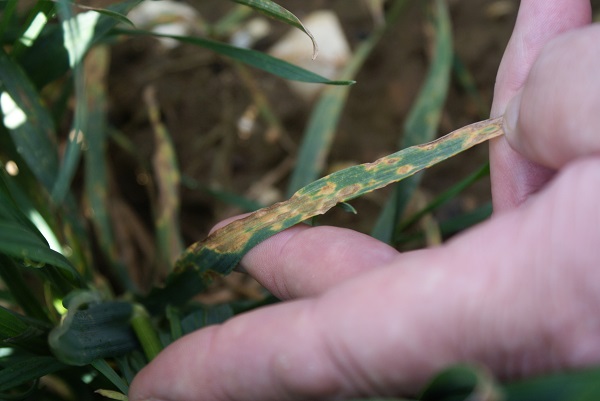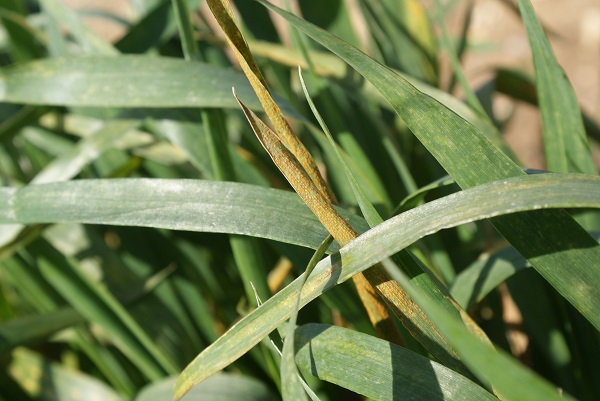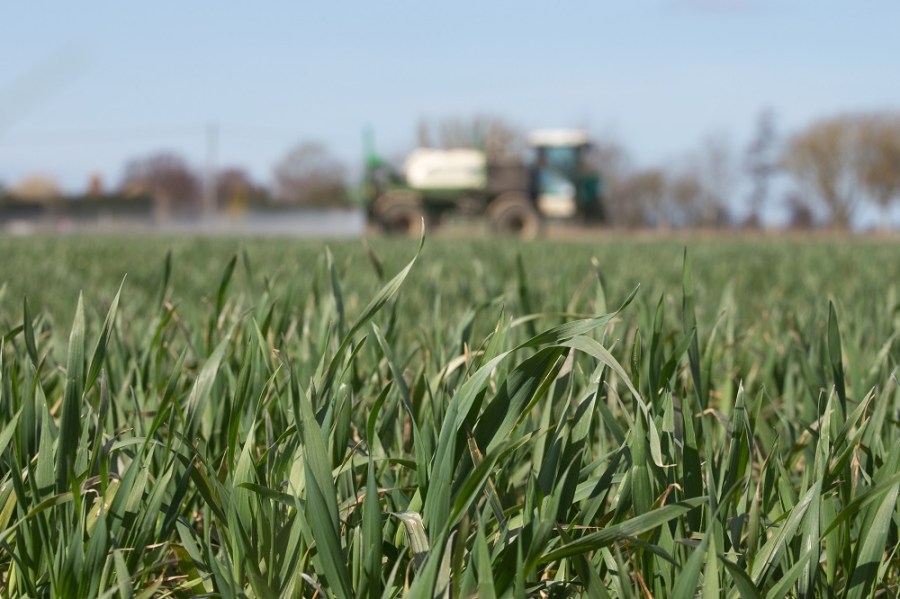After a warm soggy winter and then a cold wet early spring, 2016 is proving to be a challenging year. CPM catches up with what’s going on in the field and how agronomists are tackling diseases.
Yellow rust is evolving so quickly we shouldn’t be surprised when varieties don’t seem to be living up to their RL rating.
By Lucy de la Pasture
In terms of disease pressure, 2016 is proving to be more like the high disease year of 2014 than last year, which was comparatively clean. Yellow rust has been problematic for months in some crops, according to field reports, and very few wheats have escaped Septoria tritici infection in a year where rainfall events have been a regular occurrence. Brown rust also reportedly made an early appearance, particularly in susceptible variety Crusoe.
What looked like being an early spring turned into a late one. According to Met Office data, spring was slightly colder than normal, particularly across the southern half of the UK. All areas were colder than normal in April, with the UK mean temperature anomalies -0.2°C in March and -0.9°C in April.
Relatively dry
In terms of rainfall, spring was relatively dry across south-west England, Northern Ireland and much of western and central Scotland. In contrast, it was fairly wet across the normally drier regions of central and eastern England. Most areas had near or slightly above normal rainfall in April, producing perfect conditions for septoria infection.
“Crops were fairly slow out of the traps having stood still for a month during April, when soil temperatures stayed

Crops were fairly slow out of the traps while soil temperatures stayed firmly low in Scotland, reports Eric Anderson.
firmly at around 7°C in Scotland,” reports Eric Anderson, senior agronomist at Scottish Agronomy.
“There’s a lot of septoria in the base of crops and the continuous rain and snow showers at the end of April meant there would have been plenty of rain-splash events to proliferate septoria infection.”
But could it be that the cool, slow start to reproductive growth may actually have done us a few favours in terms of disease control by slowing its development? Eric Anderson reckons there’s some positives to take away from the slow start.
“Septoria tritici has a latent period where the fungus grows undetected inside the leaf. The disease needs to accumulate 400 day degrees between an infection event and the symptoms of septoria expressing itself on the leaves,” he explains. “That means that even if the average temperature was 16°C throughout May, it would be 25 days before symptoms were visible.”
On the plus side, that means that disease development would have been slow through April and there won’t be multiple cycles of infection occurring between fungicide sprays this season. Most T1s on Eric Anderson’s patch were applied in early May, which saw the first reasonable spraying days as wheat crops hit the T1 timing.
A possible downside to the cool spring is that if the fungus is well into its latent phase, no fungicide will provide effective eradicant activity. That means getting the timing of T2 sprays spot on is absolutely vital this season, making sure there’s no more than 28 days between sprays to ensure the flag leaf has adequate protection, he advises.
“In spite of the late start this spring, harvest will be at the same time as normal which means that crops will catch up by concertinaing their growth stages. It’s likely that the gap between T1 and T2 will be close to 21 days,” he reckons.
As far as fungicide choices go, for higher risk crops and those with greater yield potential, Eric Anderson has mostly gone down the SDHI at T1 and T2 route this season, with T1s broadly based around a tank mix of Adexar (epoxiconazole+ fluxapyroxad) plus Tracker or Enterprise (boscalid+ epoxiconazole) plus chlorothalonil (CTL). Lower risk crops received Chord (boscalid+ epoxiconazole) plus CTL. T2s are likely to be Adexar plus CTL or Aviator 235 Xpro (bixafen+ prothioconazole) on its own, with lower potential crop being treated with Proline 275 (prothioconazole) plus CTL.
Robust protection
“It’s unwise to spend too much, but it’s worse to spend too little on fungicides. It’s looking like developing into a higher disease pressure year so there’s a risk of losing substantial yield. But even in a low disease year, you’ll still get your money back if you provide robust protection to the mid-canopy of the crop,” he says. “If the crop has the potential to yield 9t/ha or above then it’s not unreasonable to spend £130-140/ha on fungicides.”

There’s a lot of septoria in the base of crops and plenty of rain-splash events to proliferate septoria infection.
At the other end of the country in Kent, Zantra’s technical director, Chris Bean, has been finding mixed levels of disease depending on the variety. Solstice is looking one of the dirtiest on farm, with yellow rust having taken off significantly in the Zantra untreated trial plots and with disease on the move even in farm crops which have had robust T0 and T1 treatments. However due to conditions, T1 was delayed by a week or so in many cases. Skyfall, which has a yellow rust rating of 6, according to the AHDB Cereals and Oilseeds Recommended List, is looking remarkably clean in comparison.
“Generally where crops had a T0, they were still relatively clean at T1, though Solstice and Claire are breaking down a bit under the pressure of yellow rust. Most crops had an SDHI plus strobilurin, Cypher (penthiopyrad+ picoxystrobin) plus a triazole plus CTL, the picoxystrobin a must for rust-prone varieties. In this part of the country we also need to be on the watch for brown rust as well with several popular varieties (Solstice, Gallant, Zulu, KWS Lili) showing signs before T1.
“I’m tending to add tebuconazole to the mix at T2, either preformulated as Prosaro (prothioconazole+ tebuconazole) or tank-mixing tebuconazole with epoxiconazole,” he says. “It’s important to mix and match, not rely heavily on just one set of actives and to ensure we cover the spectrum of disease. T0 sprays didn’t contain any epoxiconazole or prothioconazole in an effort to ring the changes.”
Preferred option
On his late drilled winter wheat, Chris Bean hasn’t necessarily gone with an SDHI at T1. Following maize and vegetable crops where crops were open and thin, his preferred option was triazole plus CTL, with the addition of a strobilurin if necessary for rusts. Some second wheats where take-all is a problem received azoxystrobin plus triazole.
His preference for T2 is likely to be a fluxapyroxad-based SDHI, such as Librax (with metconazole) or Adexar, with product choice depending on variety and disease pressure.
“Using a product based around fluxapyroxad is possibly a safer choice if it’s necessary to add in CTL because there’s no negative effect on curative activity and with the potential rust pressure that may well be important,” he adds.
Richard Alderman, agronomist at Crop Management Partners, also majored with an SDHI at T1 on his winter wheat

A lot of samples of yellow rust are being sent in this season, but a clear picture of what’s really going on in the field won’t be known until early June.
crops in the Hants and Berks regions, a decision based on the amount of disease in the bottom of crops.
“After the showery April, septoria would have spread by rain splash and would be in its latent phase as T1 decisions were being made but will express on the leaves at some point. There’s septoria in everything this year but the more resistant varieties aren’t showing as much,” he says.
Richard Alderman’s T1 sprays of choice have been Vertisan (penthiopyrad) plus epoxiconazole, Aviator, or alternatively Tracker plus Adexar in situations where eyespot was a concern. All T1s also had the addition of CTL to the mix.
Plans for T2 are likely to be based around the same three SDHIs; using Adexar plus CTL, plus a strobilurin where rusts are a particular problem. Although he may drop the CTL to aid curative activity of the fluxapyroxad if the septoria pressure continues. Aviator is his SDHI of choice in milling wheat following maize crops to help with control of the fusarium complex.
Pressing issue
In some varieties the pressing issue has been more about yellow rust, with KWS Kielder (with a disease rating of 3) and KWS Santiago (6) widely succumbing as expected under the high pressure this season. Also widely reported as picking up yellow rust in the field is Reflection, which he believes is not living up to its RL rating of 6 for yellow rust resistance, “although the breeder tells us adult resistance should kick in.”
Dr Sarah Holdgate of NIAB manages the UK Cereal Pathogen Virulence Survey (UKCPVS) and confirms that a lot of samples of yellow rust are being sent in this season, although nothing particularly unexpected that would set alarm bells ringing.
“At the moment we’re in that grey area where plants are transitioning into the reproductive growth and adult resistance begins to kick in. We won’t get a clear picture of what’s really going on in the field until early June – it’s currently too early to tell.”
From an agronomy perspective, Eric Anderson believes that with yellow rust you have to treat what’s in the front of you, regardless of whether adult resistance may kick in.
“Yellow rust is evolving so quickly we shouldn’t be surprised when varieties don’t seem to be living up to their RL rating. The information we have on yellow rust races and varietal susceptibility to them is always a year out of date. On that basis, it’s best to assume that all varieties are yellow rust susceptible.”
Even in the western counties of Heref and Shrops, yellow rust is leaving its mark, reports independent agronomist David Lines. “Early drilled Reflection has been notable for all the wrong reasons and is showing high levels of yellow rust and septoria. Timing of drilling has had a big bearing on the amount of disease in crops, with even resistant varieties showing signs of disease where they were drilled early.”
He reckons that there’s a lot of septoria infection in crops that hasn’t expressed symptoms yet because of the cold April. “Warm weather in early May will make a difference to leaves four and five, which were looking very clean when T1 sprays were applied.”
The T1 sprays applied have been based on epoxiconazole plus Vertisan plus CTL. T2 sprays will be based on either Aviator, Adexar plus CTL or Librax plus CTL, with the addition of Comet (pyraclostrobin) where rust is a problem.
“In a protectant situation I’m happy to use CTL with Aviator though may opt for one of the fluxapyroxad products if septoria pressure remains high,” he adds.
Procam agronomist, Paul Gruber agrees that the septoria infection already in crops won’t really show up until early June. In his Oxon region, Reflection is faring worse than KWS Santiago for yellow rust infection, despite both having a similar RL rating for the disease, and he’s used some Keystone (epoxiconazole+ isopyrazam) at T1 to bring it back under control where T0 applications were delayed.
“Myriad which has an RL rating of 8 for yellow rust also has more yellow rust than you’d expect, with the more susceptible Solstice (3) and Cordiale (5) not looking too clever,” he says. “In most cases I recommended SDHI plus triazoles plus CTL as a T1, opting for the extra curative activity from SDHI products containing fluxapyroxad or penthiopyrad.”
More of the same
And for T2 it’s likely to be more of the same with the fluxapyroxad product range foremost in his recommendations. CTL may be added, depending on disease and weather conditions at the time and pyraclostrobin where rusts are a problem.
Brown rust may need to be factored into some T3 sprays where longevity of control is needed, warns Richard Alderman.
“The cool conditions we had through April have helped slow down brown rust development but it was still easy to find in the base of some crops. Depending on the levels of brown rust when T3 decisions are being made, it may be advisable to add a strobilurin to the mix to ensure it doesn’t become a problem late in the season.”
However, many crops look like they have a lot of potential, believes Paul Gruber noting that Skyfall looks particularly well, as does Revelation and Crusoe.
“The cool weather in the run up to T1 might have been our saviour. It should have extended the latent period of septoria, so that T1s will still control it, even if they were slightly delayed,” he adds.
Target T3s to control fusarium
Timing is everything when it comes to fusarium ear blight (FEB) control at T3. Traditionally, T3 sprays have always been aimed at GS59 but this isn’t the best timing for FEB, says Dr Philip Jennings, Fera’s principal plant pathologist. Results from trials sponsored by Bayer, show that the difference between good and bad FEB control is just a matter of days.
“In order to study control of FEB using fungicides at different timings we inoculate trials with fusarium at a set point, so fungicide applied at GS59 (ear emergence complete) is seven days before infection and fungicide applied at GS63 (early anthesis) is three days before infection,” he explains.
The results show just how narrow the T3 window is when it comes to FEB. Philip Jennings goes on to explain, “GS59 is too early. Pollen stimulates germination of fusarium spores so when a fungicide is applied before flowering begins, all you’re getting is forward protection of up to 4 days with prothioconazole (PTZ) and up to 3 days with tebuconazole. That’s not enough for FEB control all the way through anthesis.
“At GS63 you’re getting some forward and a smaller amount of backward protection, which makes better use of the period of up to seven days (depending on product used) that the fungicide is effective against FEB.”
As with all things, there has to be a degree of compromise sometimes, but with T3 there’s little scope for adjusting timing because not hitting the optimum timing of GS63-65 means sacrificing FEB control and, as a consequence, mycotoxin levels. Generally, the trigger for a spray should be once the majority of the crop has started to flower, he explains.
“Wet weather during flowering encourages FEB, so if the weather is unsettled leading up to anthesis and forecast to remain so, then it’s better to get a fungicide on at GS59 rather than risk missing flowering, especially as the fungicides are predominantly protectant in activity,” advises Philip Jennings.
“A fungicide applied at GS59 is better than nothing, but if there’s any chance of making an application at flowering then that should be the aim for optimal control,” he says, adding that PTZ is the best option because it has longer activity if you’re having to go on early at GS59.
Achieving good fungicide coverage of the ear is also fundamental to good disease control, reminds Philip Jennings. “Once a pathogen gets in the spikelet, it can spread. Fusarium first infects individual spikelets and then spreads to neighbouring spikelets in the ear.
“If the FEB is caused by Fusarium sp. which produce DON then the infection can spread across the whole ear. The direction of spread is mostly up, so this happens where infection occurs towards the bottom of the ear.”
Using a traditional vertical nozzle to hit a vertical target with the aim of coating both sides of the ear with fungicide is practically impossible to achieve. The trials carried out by Fera have looked at different nozzle types for the past two years and results have shown a clear advantage in using double fan nozzles, angled forwards and backwards, and angled nozzles over single fan vertical nozzles, which gave the lowest level of FEB control of all.
“In 2015, there was 82% FEB incidence on our untreated trial plots. PTZ applied as Proline at 0.55 l/ha with a single fan nozzle reduced this incidence to 18% but where the same rate of PTZ was applied with a double fan, FEB incidence was just 8.5% on ears,” he says.




